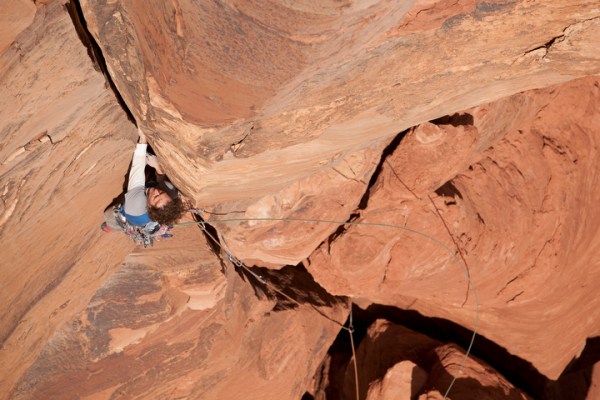James “Q” Martin’s transition from climber to climbing photographer started with a broken ankle: After climbing The Mace in Sedona in 1997, he jumped from the sandstone summit to the lower tower, snapping a bone. He decided to take a break from college, taking only his camera and a small daypack to bum around Central and South America. In Guatemala, he met French photographer Xavier Chanut, who inspired him to take action on his dream of becoming a photographer.

Photo credit: Pat Goodman
“He opened my eyes to the reality that shooting professionally does not require a degree and a ton of expensive camera gear,” Martin says. “It requires some camera gear, a lot of hard work, and a little luck.” In 2002, Patagonia bought one of Martin’s images and made it a two-page spread—the big break in his photography career. From there, his climbing experience has paid off in plenty of high, remote places: He’s rigged and shot 11 photo shoots on El Capitan alone, including a shoot for highwire walker Nik Wallenda, during which Martin and his team rigged a 1,500-foot wall, dropping 3,000 feet of fiber optic cable for a live feed while Wallenda walked across a 1,500-foot gap. His work has appeared in magazines such as Alpinist, Climbing and Trail Runner, and he’s shot for Black Diamond, Prana, Osprey and other companies.
Martin didn’t trade in his climbing gear for camera gear, however. He’s climbed hard 5.11 and 5.12 trad routes, including onsighting Indian Creek’s 5.12a Coyne Crack. He has been a member of the first ascent team on two Grade V expedition climbs: the 18-pitch 5.11 Phreenix in the Vampire Spires in Canada’s Northwest Territories in 2012; and In Gold Blood, an 11-pitch 5.12c AO on Acopan Tepui in Venezuela in 2013. His first free ascent of The Dude in Zion National Park with Bryan McCray, a 21-pitch 5.11a/b, has yet to see a second ascent after 10 years—after he and McCray climbed the whole thing in a single push in what Martin says is “probably my favorite day of climbing ever.”

Photo credit: John Burcham
“I never climbed that hard,” Martin says. “For me it’s always about keeping a level of fitness so that I can keep up while documenting adventure.”
Martin’s work continues to take him around the globe to some of the world’s most beautiful vertical environments, as he shoots climbing and BASE jumping for editorial and commercial clients. His newest challenge, though, is using photography and film to help keep the region of Patagonia wild. In 2009, he joined with activist and writer Chris Kassar to launch the nonprofit Rios Libres, with the aim of convincing Chile to not build two dams on the Baker and Pascua rivers in Patagonia. In 2013, Martin produced a four-part video series to educate and rally support around the cause. In a way, he’s paying those wild places back for the inspiration they’ve given him in his career.
“My love for photography was born from time spent in remote areas,” Martin says. “It might be on a dusty, dirt trail in Guatemala where I met a small family living off the grid or from a lofty perch in Zion. It’s those experiences that made me want to be a photographer and it’s those interactions with people and places that fuel me to be creative.”
